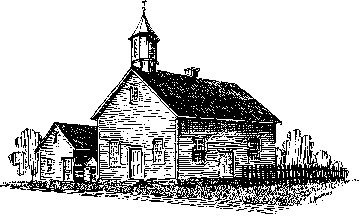“Albright’s People” began as a loose coalition of Jacob Albright’s followers. Within a few years, they were organized as a growing new denomination called the Evangelical Association, which required its own facilities and programs.
The new church became interested in German-language publishing very soon after its organization. A Book of Discipline appeared in 1809, as did a catechism. These were followed by the first church songbooks, Das Geistliche Saitenspiel and Die Geistliche Viole. In the spring of 1816, the church authorized the establishment of a Publishing House.
A plot of land (66 x 136 feet) had been purchased in 1815 in New Berlin for a church building and the Publishing House. John Dreisbach (1789-1871), the first Presiding Elder of the denomination, had bought the printing press and other equipment with his own money, and all that was needed was the building.
There are no specific details of the building’s construction. The press began operation in October 1816, so the building was certainly finished by then. It was a 1? story frame building, 20 x 26 feet, built on the south side of the lot.
The first church erected by the denomination was built on the same lot as the Publishing House. It was a one-story log building, 34 x 38 feet. The church and the Publishing House were dedicated on March 1-2, 1817.
John Dreisbach recorded the day’s events in his journal: “Saturday, March 1, 1817: The Publishing House was built by the side of the church and the dedicatory services began in the evening when J. Stambach preached from Matt.26:41. After him I preached from Acts 3:19, and it went quite well for me.”
The first General Conference of the Evangelical Association was held near New Berlin in October 1816, as were those in 1820, 1826, and 1847. The missionary society was organized near New Berlin in 1839, and the church’s first educational institution, Union Seminary, forerunner of Albright College, was founded in New Berlin in 1854.
Church headquarters remained in New Berlin until 1853, when they moved west to Cleveland, Ohio in the footsteps of German-speaking immigrants to the Northwest Territory.
Points of interest at this Heritage Landmark: Nothing remains of the original structures. A marker was dedicated at the site on August 2, 1927.
Several other places related to the history of the Evangelical Association are also in New Berlin, including the site of Union Seminary, the gravesite of George Miller, and artifacts from First Evangelical Church (the latter are housed in Emmanuel United Methodist Church).
Parking is available on the streets near the marker.
Special events: None
Area attractions: Other places in the area with Evangelical Association ties include the site of the second Evangelical publishing house and the Maize, Dreisbach, Dunkel, and Eyer farms. New Berlin lies in the foothills of the Appalachian Mountains, near the Susquehanna River. Nearby towns include Lewisburg, Sunbury, and Selinsgrove, and Williamsport is further north.
To visit: The marker is accessible at all times.
Location: Within the boundaries of the Susquehanna Annual Conference in Union County, Pennsylvania. The marker is at Plum and Water Streets along Penns Creek (two blocks south of Market Street).
Food and lodging: There are motels and restaurants in New Berlin, Lewisburg, and Shamokin Dam.
Directions: Drive south from Interstate 80 on Route 15 to Lewisburg. Turn west onto Route 45, and drive four miles. Turn south onto Dreisbach Church Road/New Berlin Mountain Road, five miles. Turn east on Market Street and drive one block. Turn south onto Plum Street, and drive two blocks.
For further information, contact: Dr. Milton Loyer, Loyer@lycoming.edu.
To learn more about United Methodist church history in this area:
Susquehanna Annual Conference Archives, Snowden Library, Lycoming College, 700 College Place, Williamsport, PA 17701; Milton W. Loyer, Archivist; 570-321-4088.
Arthur C. Core, Evangelical United Brethren Reader: A Documentary Source Book (Dayton, OH: United Theological Seminary, 1963).
Charles R. Miller and William L. Raker, The Histories of the Pennsylvania and Central Pennsylvania Conferences of the Evangelical United Brethren Church (York, PA: by the authors, 1968).

